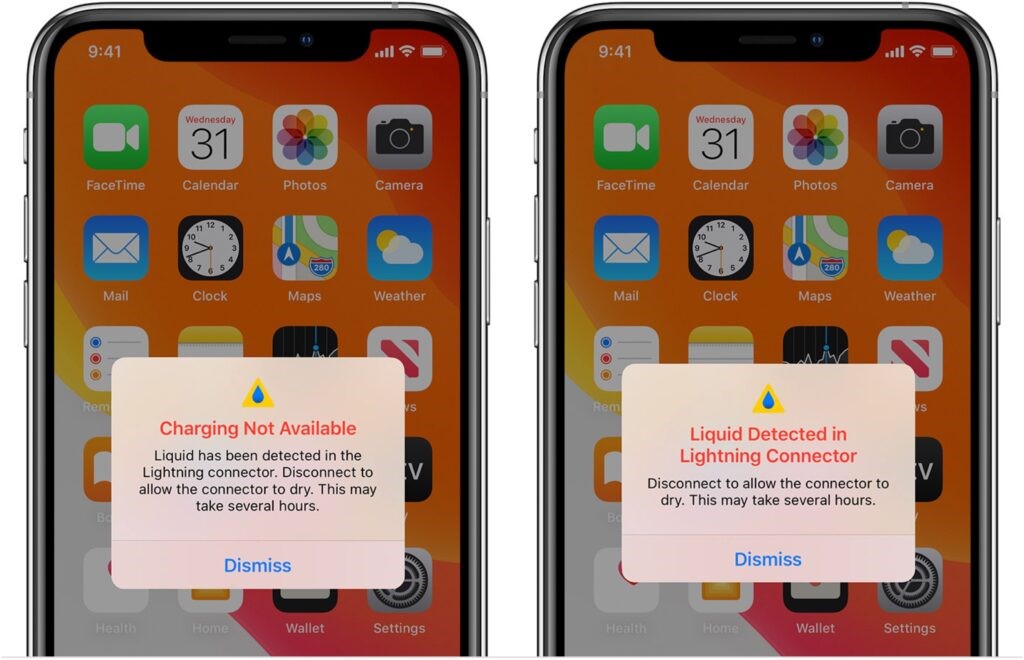Apple has designed the iPhone with significant levels of splash and water resistance, so briefly exposing your iPhone to rain—or even a quick dunk—may not result in any issues. But accidents happen, and if your iPhone gets wet, the following advice can help you dry it out.
First, you should understand the waterproof level of your phone. All iPhones have a two-digit IP rating (Ingress Protection) that identifies what amount of water exposure they should be able to handle when new. The first digit specifies the protection against solid objects like dust; a rating of 6 means the device is dust-tight (no dust can get in). The second digit indicates the protection against water. A rating of 7 means the device is protected against the effects of temporary immersion in water, under standardized conditions of time and pressure. A rating of 8 means the device is protected against the effects of continuous immersion in water. The manufacturer specifies the conditions for this higher rating, but they must be more severe than rating 7.
Current and recent iPhone models are rated at IP68, with the older iPhone 7, 8, XR, and second-generation SE models rated at IP67. And Apple has been improving the water resistance of iPhones. The iPhone 11, XS, and XS Max are designed to withstand immersion at a maximum depth of 2 meters for up to 30 minutes. The iPhone 11 Pro and 11 Pro Max increase the depth to 4 meters, and every newer model can handle the increased pressure of up to 6 meters.
Water resistance is not a permanent condition, however. It depends on tight seals and gaskets that are weakened by age, drops, disassembly, extreme temperatures, and exposure to chemicals (such as sunscreen or insect repellent). So the older your iPhone, the less likely it meets the criteria of its IP rating.
When your iPhone does get splashed—like in the rain, for example—just dry your iPhone off with a cloth. If your iPhone is spilled upon—such as by an accidental tip-over of your coffee—rinse the affected area with tap water and then dry it with a cloth. For splashes and spills, we recommend waiting to plug in a Lightning cable until the iPhone has had time to dry out.
Although IP ratings indicate iPhones can withstand immersion for up to 30 minutes, try to get your iPhone out of the water as quickly as possible. Then, take these steps:
- Immediately turn off your iPhone with the power slider, which appears when you hold the side button plus the volume button (Face ID iPhones) or side button (Touch ID iPhones).
- If you dropped your iPhone in anything other than clean, fresh water—such as a muddy puddle, the ocean, a swimming pool, or the toilet—rinse it under tap water.
- Dry the exterior with a soft cloth. Do not use a hair dryer, any heat source, or compressed air.
- Tap your iPhone gently against your hand, with the Lightning port and speaker facing down, to remove excess liquid. Do not insert anything (such as a cotton swab or tissue) into the Lightning connecter or SIM tray—just let any water inside evaporate.
- Open the SIM tray and leave the iPhone in a dry area with airflow. Direct a fan at the openings when possible.
- Leave your iPhone off, and let it dry for at least 5 hours, and up to 24 hours. While wireless charging should be okay, do not connect a charging cable, or any other cable, until the iPhone is completely dry. Recent iPhones will warn if they detect water in the Lightning port.

The classic advice for a water-damaged electronic device is to bury it in a container of uncooked rice for a day or two, with the idea that the rice absorbs the moisture in its vicinity. This approach can work, but Apple advises against it, due to the likelihood of getting tiny bits of rice in the Lightning port. If you want to use rice, loosely wrap your iPhone in a paper towel first to protect its ports. A better approach is to use a sealed plastic bag containing silica gel desiccant packets (like those in vitamin bottles). They are inexpensive and readily available—but of course, you must have them on hand.
Additionally, if the speaker on your iPhone sounds muffled, some people suggest playing a particular sound to eject water: visit FixMySpeakers and tap the button. While this is clever and shouldn’t hurt anything, if there’s water in the speakers, there is probably water elsewhere too. Thus, the safer option is to turn off the iPhone and let it dry naturally.
Note that Apple does not claim any sort of water resistance for iPads or MacBooks. If one of them gets wet, you can try following our advice, but know that a repair is likely in your future. No matter your device, we’d love to hear how these tips helped you!
